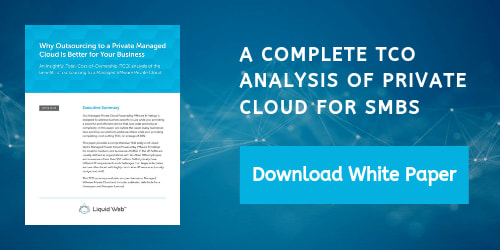
Is your business looking for more agility and cost savings in 2020? Consider Managed VMware.
Businesses continue to turn to IT infrastructure virtualization to make their systems more agile and cost-efficient, and VMware continues to be the leading virtualization technology platform.
VMware is generally packaged and implemented as a managed solution, although there are companies that completely manage their own VMware-powered environments.
Those that do it successfully tend to operate in the IT infrastructure industry, and therefore have virtualization expertise as part of their core. Others attempt to achieve cost savings, but generally end up paying more, with reduced system efficiency or performance, and possibly security or compliance risks.
One of the advantages of VMware is the enormous range of workloads it supports.
The vSphere 6.7 platform is billed by the company as the “universal application platform,” and provides all the tools necessary to architect, provision, deploy, monitor, and manage environments. The complexity this entails, which has given rise to terms like “VMware sprawl,” is where most of the challenges arise when trying to manage your own VMware set-up.
If you are considering managing the set-up of your own VMware system, you should be aware of these challenges. If you are planning to perform management in-house, your team must be ready to tackle them.
Configuration
The dreaded “Configuration Issues” error can arise from any one of numerous VMware services. It always results in an expenditure of time, and if not properly addressed, in other headaches, and possible service disruptions.
To make sure your VMware environment is configured properly, you must first identify which version of vSphere suits your business needs, how much storage you will need in the short to medium term, and how that storage should be deployed.”
The latest version is vSphere 6.7, and for most businesses will be the version you want to use. You do need to make sure that each new version of vSphere is mature and supports the rest of your environment, however.
The initial size of your VMware environment is determined in part by your resource needs, and in part by your architecture.
If you require high availability, for instance, you need to build redundancy into the system, and deploy a load balancer. You may also want to deploy separate web and database servers to improve performance, and in some cases meet security or regulatory requirements.
Other important decisions you need to make to configure your system correctly are whether you should use traditional or Software Defined Networking, how to handle resource allocation and oversubscription, and how to migrate to your new environment.
Misconfigured systems can lead not only to visible errors and performance breakdowns, but also to security and compliance issues, as examined below.

Monitoring
Support for numerous servers running diverse workloads in various different environments, while a strength of VMware, also makes system monitoring problematic for many businesses.
Performance monitoring company eG Innovations surveyed VMware users on their most common challenges with monitoring VMware environments, and found that nearly half consider diagnosing problems slow and complex, and 45 percent say they have a lack of visibility across their virtualized environment.
VMware actually provides a wealth of monitoring tools and capabilities, but utilizing them efficiently requires expertise. Experts managing VMware systems are able to maintain visibility across multiple servers, workload types, and infrastructure environments, enabling them to handle businesses’ ongoing performance requirements and capacity management.
Properly implementing a full range of monitoring tools can be challenging, but is also not enough on its own. Services should be proactively monitored 24/7/365, another unnecessary burden for most businesses to take on.”
In any situation where the organization is having trouble monitoring its infrastructure, there are bound to be problems. When it is properly monitored, however, necessary changes can be anticipated, and the system can be scaled to keep business processes running smoothly.
Optimization
Part of the power that VMware gives businesses is the ability to allocate resources flexibly in order to meet their specific needs at that time. Organizations with strong monitoring, whether in house or by a managed services provider, can identify free resources even before they come available, and allocate them to the workloads where they will be most helpful.
Even with full visibility of virtualized infrastructure, knowing how to optimize your system to take full advantage of the resources you have may require in-depth knowledge of memory swapping, the comparative strengths of fixed-size and dynamically allocated disks and a host of other performance tuning and resource optimization tools and methods.
Even highly competent IT professionals can find configuring VMware for performance challenging, as this blog on SysAdmin community 4sysops makes clear.
If your IT team does not have and know how to use all of the right tools, a managed VMware solution will be more cost-efficient and effective.

Compliance and Security
Keeping on top of the vulnerabilities and patches that come up within any complex IT ecosystem can be a challenge. For businesses running private clouds that they set up and manage on their own, the risk of being caught on the wrong side of regulation or suffering a breach is potentially very high, and very costly when remediation costs, reputational cost, and possible fines are added up.
Maintaining the security of your virtualized environment requires following best practices in firewall permissions, and other security tools, as well as infrastructure components.
VMware provides a manual on Security Best Practices for vSphere infrastructure, but also clearly states that it “…is only one of the sources you must use to ensure a secure environment.”
Even in a fully managed deployment, businesses that have a dedicated vCenter instance can maintain a significant degree of visibility and access into their systems, while preserving the security, performance, and efficiency of a managed solution.
Achieving those same performance and consistency levels by managing your own VMware solution is possible, for some organizations in certain situations, but is rarely an efficient use of employee time and energy.
See How VMware Private Cloud Can Save Your Business Money
[ad_2]
Source link


![VMware Management and Setup [Four Challenges to Expect]](https://dealzclick.com/wp-content/uploads/2022/02/AnkerWork-PowerConf-C300-AI-Powered-Webcam-Launched-in-India-Offers-Full-HD.jpg)
![VMware Management and Setup [Four Challenges to Expect]](https://dealzclick.com/wp-content/uploads/2022/02/Text-Your-Wife-Into-Bed.jpg)



